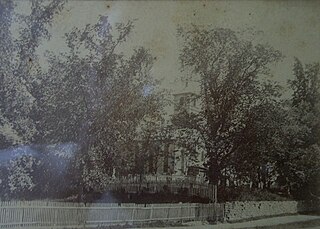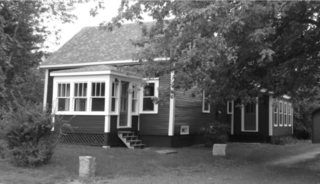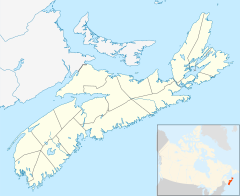
Sackville is a former town in southeastern New Brunswick, Canada. It held town status prior to 2023 and is now part of the town of Tantramar.

Port-Royal National Historic Site is a National Historic Site located on the north bank of the Annapolis Basin in the modern community of Port Royal, Nova Scotia, Canada. The site is the location of the Habitation at Port-Royal which was the centre of activity for the French colony of Port Royal in Acadia from 1605 to 1613 when it was destroyed by English forces from the colony of Virigina.
Beaubassin was an important Acadian village and trading centre on the Isthmus of Chignecto in what is now Nova Scotia, Canada. The area was a significant place in the geopolitical struggle between the British and French empires. It was established in the 1670s on an upland close to an extensive area of saltwater marsh. Settlers reclaimed the land to engage in cattle ranching and trade.

Annapolis Royal, formerly known as Port Royal, is a town located in the western part of Annapolis County, Nova Scotia, Canada.

Fort Anne is a historic fort protecting the harbour of Annapolis Royal, Nova Scotia. It was built by Scottish settlers in August 1629 as Charles Fort. For the first 120 years of the fort's active period, the settlement of Port Royal / Annapolis Royal was the capital of the New France colony of Acadia and British North America colony of Nova Scotia. In 1917, Fort Anne became the first National Historic Site of Canada. Although no longer in active service, it is the oldest extant fort in Canada. Fort Anne has provided more defensive service than any other fort in North America, having been attacked and blockaded at least 19 times over a service period of 225 years, from the Acadian Civil War through to the American Revolutionary War. The fort also contains the oldest military building in Canada and the oldest building administered by Parks Canada, the 1708 powder magazine.

Grand-Pré is a Canadian rural community in Kings County, Nova Scotia. Its French name translates to "Great/Large Meadow" and the community lies at the eastern edge of the Annapolis Valley several kilometres east of the town of Wolfville on a peninsula jutting into the Minas Basin surrounded by extensive dyked farm fields, framed by the Gaspereau and Cornwallis Rivers. The community was made famous by Henry Wadsworth Longfellow's poem Evangeline and is today home to the Grand-Pré National Historic Site. On June 30, 2012, the Landscape of Grand-Pré was named a World Heritage Site by UNESCO.

Grand-Pré National Historic Site is a park set aside to commemorate the Grand-Pré area of Nova Scotia as a centre of Acadian settlement from 1682 to 1755, and the British deportation of the Acadians that happened during the French and Indian War. The original village of Grand Pré extended four kilometres along the ridge between present-day Wolfville and Hortonville. Grand-Pré is listed as a World Heritage Site and is the main component of two National Historic Sites of Canada.

Fort Edward is a National Historic Site of Canada in Windsor, Nova Scotia, and was built during Father Le Loutre's War (1749-1755). The British built the fort to help prevent the Acadian Exodus from the region. The Fort is most famous for the role it played both in the Expulsion of the Acadians (1755) and in protecting Halifax, Nova Scotia from a land assault in the American Revolution. While much of Fort Edward has been destroyed, including the officers' quarters and barracks, the blockhouse that remains is the oldest extant in North America. A cairn was later added to the site.
Paradise is an unincorporated community in the Canadian province of Nova Scotia, located about 30 km (18 mi.) northeast of Annapolis Royal in Annapolis County. The original French name, dating to 1684, was Paradis Terrestre, or Earthly Paradise.

The Duc d'Anville expedition was sent from France to recapture Louisbourg and take peninsular Acadia. The expedition was the largest military force ever to set sail for the New World prior to the American Revolutionary War. This effort was the fourth and final French attempt to regain the Nova Scotian capital, Annapolis Royal, during King George's War. The Expedition was also supported on land by a force from Quebec under the command of Jean-Baptiste Nicolas Roch de Ramezay. Along with recapturing Acadia from the British, d'Anville was ordered to "consign Boston to flames, ravage New England and waste the British West Indies." News of the expedition spread fear throughout New York and New England.

The Old Parish Burying Ground is the oldest protestant cemetery in Windsor, Nova Scotia and one of the oldest in Canada. The graveyard was located adjacent to the first protestant church in Windsor (1788). The oldest marker of Rachel Kelley is dated 1771, twelve years after the New England Planters began to settle the area.

The Bailey House in Annapolis Royal, Nova Scotia, Canada is a historic house built around 1770, making it the one of the oldest wood frame houses in Canada. It has been operating as a lodging, with interruptions, since at least 1837. The building is a Georgian style and is largely unaltered since its original construction. The house is part of the Annapolis Royal Historic District.

The Adams-Ritchie House is one of the oldest wood framed buildings in Canada. It is located in Annapolis Royal, Nova Scotia, Canada and dates from 1713. Over the past 300 years, the building was expanded and embellished until the original building was completely hidden. In the 1980s, it was restored to its original appearance. Prior to 1749, the house occasionally hosted the Nova Scotia Council, the fore-runner of the Nova Scotia House of Assembly.

North Hills Museum is a house-museum located in Granville Ferry, Nova Scotia, Canada. It is a neoclassical house built around 1764 and is one of the oldest wood framed buildings in Canada. It was bought in 1784 by the Ambermans, a Loyalist family from New York State, who owned the house for six generations. In 1964, it was purchased by Robert Patterson, an antique collector who restored the house to an 18th century appearance. Upon his death in 1974, he willed the house to the Province of Nova Scotia.

For the main article on the town, see Annapolis Royal

The Annapolis County Courthouse is a courthouse located in Annapolis Royal, Nova Scotia, Canada. It was built in 1837 by Francis LeCain and was enlarged in 1923. The building is designated a National Historic Site of Canada. It is part of the Historic District of Annapolis Royal and is one of the oldest courthouses in Canada still in use.
The O'Dell House Museum is a house-museum located in Annapolis Royal, Nova Scotia, Canada which presents a collection of artefacts important to the history of Annapolis Royal. The museum also houses the Annapolis Heritage Society's Genealogy Centre and its Archive and Collections Centre. The original building was constructed in 1869 by Nova Scotia Pony Express rider, Corey O’Dell. A Victorian house in Greek revival style, it is part of the Historic District of Annapolis Royal.

The Bonnett House in Annapolis Royal, Nova Scotia, Canada is a historic house built around 1773, making it the one of the oldest wood-frame houses in Canada. The building is a Georgian style and is largely unaltered since its original construction. The house is part of the Annapolis Royal Historic District.

The Williams House is a historic house located in Annapolis Royal, Nova Scotia, Canada. Constructed in 1715, the building was located at 248 Saint George Street until 1875 when the main portion of the house was moved to 167 Saint Anthony Street. The ell of the house, dating from c. 1730, was moved to 62 Chapel Street. Although the location has moved, it remains one of the oldest wood-framed houses in Canada. The building is part of the Historic District of Annapolis Royal.
















